Permits or Licenses: A Fine Line
by BONZO, HSM team writer
Whether you appreciate Apple as a company or as a product, whether you appreciated Steve Jobs as a man or as the legend he has became or not, it was a day that sent ripples through the world on the day he passed away. There were countless tributes to his legacy and many paid homage to him in appreciation for what he helped to establish in our modern world. I paid my own homage in Home when I tried my best to emulate his image in my avatar. I also tried my best to emulate Hunter Thompson on the anniversary of his death (February 20th 2005).
No, there isn’t a Steve Jobs costume in the store, nor is there a Hunter Thompson costume either, but Home users have proven to be a very creative and resourceful lot. Lockwood has supplied us the means to emulate Marylin Monroe, Arthur Miller, Young Elvis and James Dean with their outfits, but you as a user have to put it together because they can’t sell a costume with either name attached, at least not without a licensing agreement. Remember though, that neither of these people designed the clothing that we visualize when we recall them, they just made the clothes iconic by wearing them.
There is a very fine line between what is permitted by licensing agreements, and what violates copyright law. There are countless outfits I would love to see in the store but likely we will never see, because trying to get two power companies to agree on licensing can be near impossible sometimes. There are some available only in foreign regions that irk me to no end that we can’t have here in North America, but that is a licensing agreement with one entity in a separate region than the one we occupy. Some outfits have been available with limited licensing agreements with Home, some have been purely the ingenuity of user generated content, and others well… they walk a very fine legal line. Sony wouldn’t risk unnecessary lawsuits, so I am sure they know exactly just how far to go.
There is a clear difference between a fully licensed product, e.g. Star Wars outfits like storm trooper, C-3P0, and others as Indiana Jones, Predator, Scream, Aliens, etc. and what hints at – but doesn’t fully claim to be – certain characters. If you don’t know what I am talking about take a peek through the costumes store and you’ll likely recognize a few characters in there. There is the undead bride and groom – Corpse Bride, anyone? Then there is the stick man costume (or Jack Skellington’s cousin), Monster Gorilla and Monster Lizard outfits (King Kong and Godzilla).
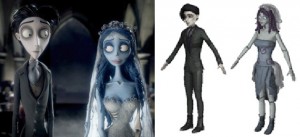
In all fairness, King Kong is a public domain, as established in a lawsuit Universal City Studios tried to file against Nintendo after they released Donkey Kong. Godzilla however is not. If you are a fan and follower of the Sea Shepherds Conservation Society (and I hope you are), you may know that they christened a vessel Gojira – Japanese for Godzilla – which they used to harass the illegal poaching of whales in the southern seas in the guise of “research.” They were however forced to change the name of the vessel after accusations that it violated copyrights on the name.
Outfits aren’t the only products that ride the fence of liabilities. Since day one, we have probably wanted an R2D2 companion; I know I have. I have seen the R2D2 model in Star Wars promotions, but SCE doesn’t have a current licensing agreement to develop or sell that character, so it remains a marketing prop and not a decorative item we can purchase or a companion that would follow us.
The Stichkins Ponies are very similar to My Little Pony, but they aren’t a Hasbro product, as Hasbro currently doesn’t have anything to do with Home. It would be an ideal addition to Home, as many of us have probably wanted Transformers related content as well – hopefully original animation Transformers and not the movie versions.
Until that happens – if it ever does happen – we have Lockwood’s awesome IronFusion MechJets; at least they transform. CAS body armor suits were a great disappointment since they hinted at transformation, but never actually did. We now have a new companion, the Super Pup hitting the virtual shelves, but you slap a “S” logo on a diamond emblem and you have Krypto.
Munnys, Dunnys, Modnation Racers or Peeps – tell me if you spot the similarity. If you have never heard of Munnys or Dunnys, they are a line of designer toys under the Kid Robot trademark, originally sold as blanks for buyers to design and color themselves, but then began to license limited editions of established pop artist created designs into what has essentially become an oversaturated market. Many of them came with interchangeable accessories much as that classic toy, Mr. Potato Head.
These commodities, though we recognize them for what they represent, aren’t directly licensing the exact trademarked images we see in them, but they are close enough that we don’t care if the name is King Kong or Monster Gorilla. Sometimes you play around the rules, you exploit loopholes, and if anyone knows about exploits, it’s gamers.
Which brings me to the other point – the user generated outfits.
How many of us haven’t seen Jesus running around, or done a double take the first time we saw Michael Jackson? Our pop culture has seared our brains with iconic images that we immediately recognize when we see them. Thus far, I have seen users creatively put together Blues Brothers outfits, Walter from The Big Lebowski, Jules and Vincent from Pulp Fiction, Jim Morrison from the Doors, Wonder Woman, the Avenger’s Emma Peel and John Steed, Ghost Rider, and Borg from Star Trek, just to name a few. Users will always find a way of emulating or honoring the pop culture icons that appeal to us. It doesn’t necessarily violate copyright law as it is not by design, but by user resourcefulness. Much as Minecraft is a software that gives you the tools to create with blocks representing pixels, what users create with them is entirely up to them.
While some may call these unlicensed products knock-offs, it is an element of real life business hence why copyright laws exist, but copyright law – at least in the United States – amends a doctrine for fair use and fair dealing. What that means is you are permitted to some copying and distribution without permission of copyright holder, and although the law is not specifically defined, there are a few criteria to meet. The most important of which is – is it different enough?
It is a gray area, and disputes arise often; the courts are loaded with copyright infringement lawsuits. Bethesda just recently threatened a lawsuit against Mojang studios – developers of Minecraft – over the trademark “Scrolls” a new game in development, because they felt it infringed on their long running franchise Elder Scrolls.
Lawsuits are left to the discretion of the copyright holders as to whether they wish to file lawsuits and pursue long legal disputes. Often, copyright holders will initialize procedures by means of a warning to cease and desist. A formal order to stop all illegal activity concerning a copyright or trademark and to not take them up again later or face a lawsuit. In a twist of fate, Universal City Studios ended up having to pay Nintendo nearly two million in damages as a result of their lawsuit over Donkey Kong. Laws are funny things, particularly in a global economy, where you can’t often get nations to agree on passing laws, let alone enforcing them. Off branding is pretty rampant where developing nations often copy established brands. One needs to look no further than China to see many examples of this.

Image credits Johnathan Mark Long, Chris Thornley "Raid71" and Farzin Adeli respectively. 3 Designers spread over the globe, ONE design.
At times the blurred lines of copyrights are crossed unintentionally. Consider that in the millennia that modern humanity has existed and has been an imaginative animal, we have influences that attack our creative sensibilities. We can’t help come up with something that is inspired by someone else’s work that has influenced us in the past. This is why cultural and period aesthetics are very similar, because they are variations of similar designs and trends.
If you are familiar with Lord of the Flies, consider the similarities with Battle Royale, and the similarities between that and the recent film adaptation of The Hunger Games. We are now a world of over seven billion people, and have so many means of communication that the odds are good multiple people will come up with the same ideas.
Logos are another element that often mirror each other. Following the death of Steve Jobs, a young design student living in Hong Kong was credited with the design of the infamous Apple logo with the profile of Steve Jobs’ face after it went viral, but a similar – actually an inverted exact copy of it – was already a design of an established artist in Europe; a third designer was thrown in the mix after his own very similar design came out. The ironic thing about that controversy was that they were all variations on an already established design, the Apple logo, which itself was part of a long running dispute between Apple Computers and Apple Corps, a multimedia corporation established by the Beatles. Speaking of music, Codeglue’s Mesmo logo looks remarkably like an upside down Factory Records logo without the smokestack, coincidence or influence?
Are we violating copyright laws by making a Michael Jackson, Elvis, Marilyn Monroe avatars? Be at ease – you aren’t. Think about this: you go to a tattoo artist with a picture of a Storm Trooper and say, “I want this tattooed.” Who is violating copyright law – you or the tattoo artist? Technically, it’s the tattoo artist, as he is making money on it, but the reality is that it’s neither.
It is one of those gray areas of fair use where you as a customer are asking for a custom tattoo, which you are paying the tattoo artist for his services not for the image. George Lucas doesn’t offer tattoo services, and a tattoo artist isn’t going to interfere with Lucas’ market shares by providing a custom tattoo service. The artist though, cannot advertise Star Wars tattoos as his services, then he would be violating copyright law.
So go nuts, enjoy yourself playing with the wardrobe options and see what you can come up with. I sincerely hope they bring us more options that play with the fuzzy borders between what is permitted and what is licensed.


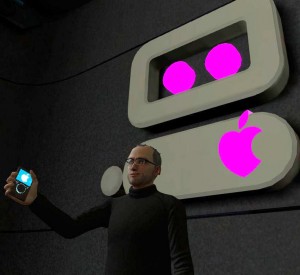
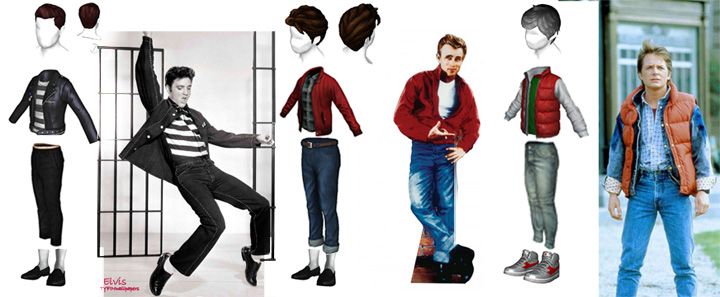



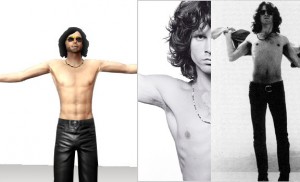
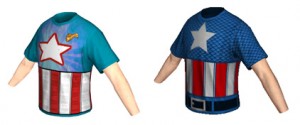
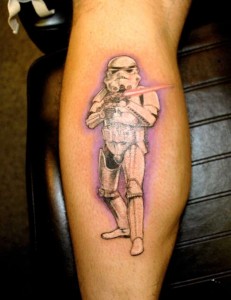
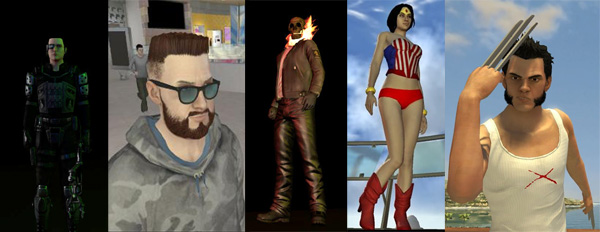
 Twitter
Twitter
I love the costuming ideas that others come up with to emulate famous people. I have a good friend who has Micheal Jackson down pat. The only times I have tried this is for doing a film, when I am trying to duplicate a character, like in the latest Homeymooners one I did with Granny. I might look at a few people and try and come up with one just for the fun of it someday when I am looking for something to do.
I do think that many brands are missing the boat in Home though, especially if they are game related. Cloud, Tifa, Barrett, any of the old or newer Final Fantasy characters would sell like hotcakes in here.Square already has a presence here with the Primarchs and the FF 13 costumes. They could make a bit of money with FF 7 and FF 10 costumes as well. There are probably an endless amount of different franchises who could benefit in Home and sell quite well.
Interesting article Bonzo, makes you wish for more of these kinds of things being made available in Home. Though user created ones are fun too.